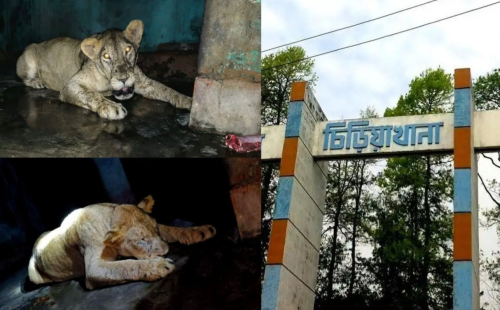Where have all the squirrels gone?

Once, the rooftops, orchards, and gardens of Bangladesh
stirred with the restless energy of squirrels. They darted through mango and
jackfruit trees, their striped bodies flickering like quicksilver among the
leaves. Children watched in delight as they leapt from branch to branch, while
elders placed offerings of rice in clay pots for their tiny guests.
The Indian palm squirrel (Funambulus palmarum), with its
three pale stripes and plume-like tail, was more than just a familiar sight. It
was a gardener of the wild—scattering seeds, carrying pollen, and sounding
alarm calls that rippled through the village fauna. Yet, slowly and silently,
these bright-eyed creatures are slipping away. Their absence is not loud or
sudden, but like the fading of a season, it unsettles the balance of nature
itself.
"Squirrels are sensitive indicators of ecosystem
health. If they're declining, it signals that something has gone wrong at the
very foundation," laments Dr Tareque Hasan, Wildlife Ecologist at Dhaka
University.
Why are the squirrels disappearing?
Indian Palm Squirrel. PHOTO: MUHAMMAD MAHDI KARIM/ WIKIMEDIA
1. Choking on pollution
Pesticides sprayed on crops and gardens do more than kill
pests—they poison food chains. Squirrels, who nibble on fruits, seeds, and even
bark, often ingest these toxins directly or accumulate them over time.
Meanwhile, air pollution from vehicles and brick kilns has been linked to
respiratory stress in small mammals.
2. Loss of trees, loss of homes
Squirrels nest in tree hollows, dense foliage, and even
thatched roofs. But with urbanisation and deforestation speeding up across
Bangladesh, their habitats are disappearing. Fruit trees are cut down to make
room for concrete. Old trees are replaced with fast-growing, non-native species
that lack suitable nesting spaces. The few remaining trees are often isolated,
pruned, or sprayed with chemicals, making them inhospitable to wildlife.
3. Noise and human disturbance
Construction noise, fireworks, loudspeakers, and
unregulated tourism in natural spaces all take a toll. Squirrels are skittish
by nature—when stress becomes chronic, their reproductive rates drop, and young
fail to survive. Even something as innocent as a curious child chasing a
squirrel up a tree can disrupt its feeding or nesting cycle if repeated often
enough.
4. Predation and road Accidents
With shrinking green spaces, squirrels are forced to forage
on the ground, putting them in the path of feral cats, dogs, and speeding
vehicles. Roadkill incidents involving squirrels are quietly increasing across
urban fringes.
An orange-bellied Himalayan squirrel leaps between trees in
Rangamati’s Kaptai National Park. Found across Bangladesh, India, Nepal,
Bhutan, Myanmar and China, this arboreal rodent is herbivorous and known for
its agility. Its dark or reddish-brown fur contrasts with its striking orange
belly, making it one of the region’s most colourful squirrels. Usually solitary
except in breeding season, its numbers are dwindling due to deforestation. The
IUCN lists the species as “Near Threatened.” PHOTO: NOBEL CHAKMA
What can we do—before it's too late?
Individuals
• Plant native trees like jackfruit, mango, banyan, and
coconut, species that squirrels prefer.
• Avoid harmful chemicals in your garden. Use natural
pesticides or permaculture methods.
• Leave food: Rice grains, fruit peels, or nuts can
help squirrels thrive in safe spots.
• Teach children to observe—not chase or
catch—wildlife.
Communities & policymakers
• Create urban green corridors with squirrel-friendly
trees.
• Include small mammal conservation in biodiversity
and forestry policies.
• Install eco-bridges or canopy ropes over roads in
squirrel-dense zones.
• Launch public awareness campaigns using schools and
media.
A future without squirrels?
Can you imagine a forest without rustling leaves? A morning
without tiny feet scampering across your roof? A tree without a nest tucked
inside its arms?
The squirrel is not just a symbol of nature—it is a thread
in its fabric. If we let that thread break, we risk unraveling the entire
tapestry.
So, the next time you see a squirrel, take a moment. Watch
it. Protect it. Celebrate it.
Because if we don't, one day our children may ask,
"Where have all the squirrels gone?"
















